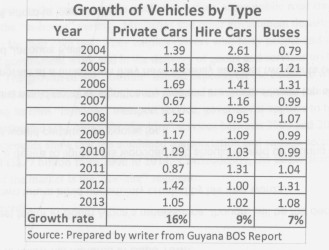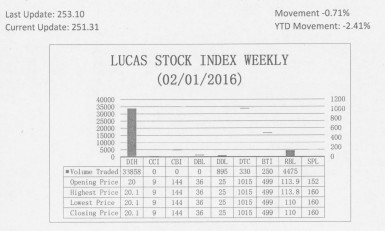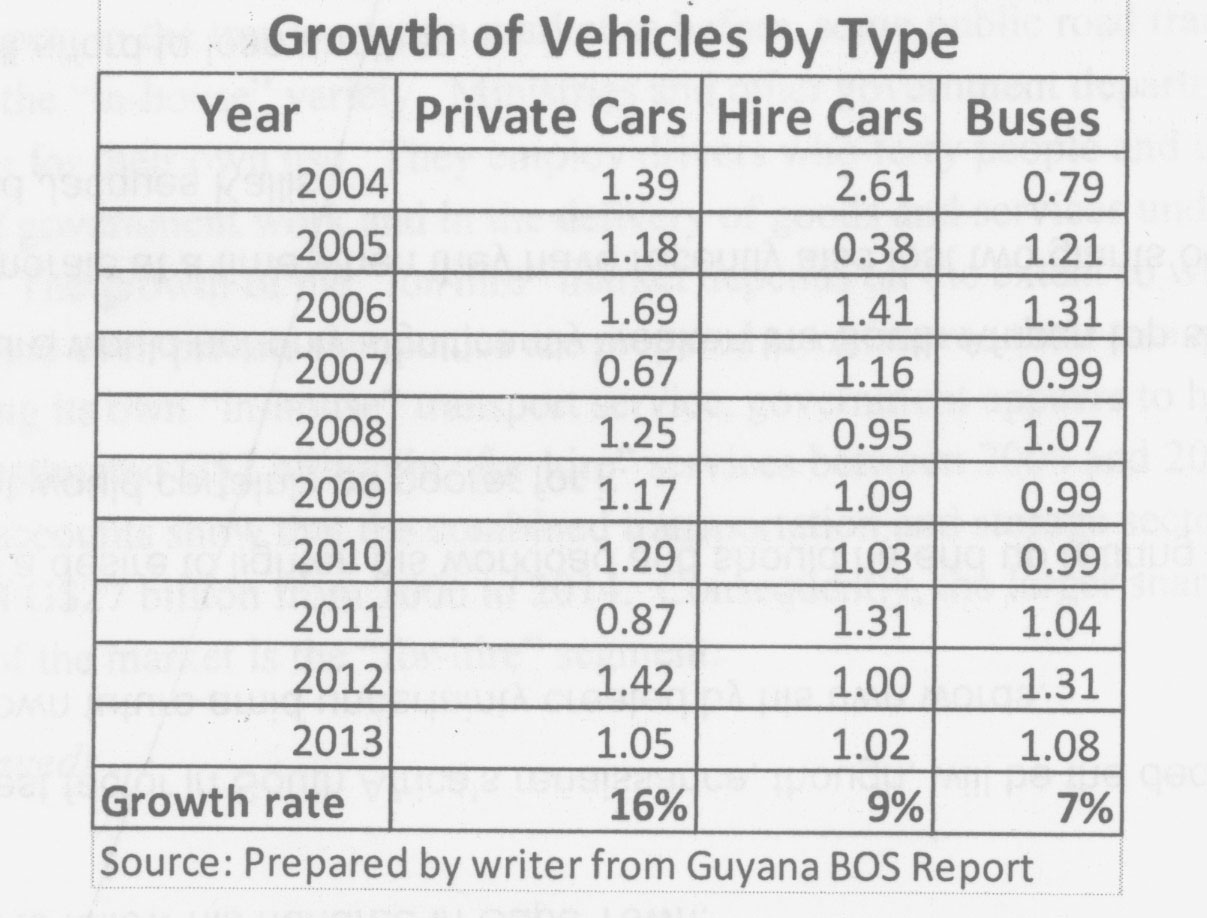World of transportation
 This article is an attempt to unravel the complex world of the transportation service in Guyana. One sees the positioning and movement of taxis, minibuses, vans and lorries along the roads and one might believe that the transport industry is simple and straightforward. However, the industry is far more complex than meets the eye and could easily fool one into believing that there was very little to trouble policymakers. As this and subsequent articles will seek to show, the transport industry is one that needs to be properly and almost immediately studied if Guyana is to become a major economic competitor in the region and around the world. It is one of the economic activities that social media might not be able to restrict as it does other types of economic activity. Instead, the demand for transport services is likely to grow as internet technology enables more people to gain access to a wider array of suppliers and as the economic structure of the country changes.
This article is an attempt to unravel the complex world of the transportation service in Guyana. One sees the positioning and movement of taxis, minibuses, vans and lorries along the roads and one might believe that the transport industry is simple and straightforward. However, the industry is far more complex than meets the eye and could easily fool one into believing that there was very little to trouble policymakers. As this and subsequent articles will seek to show, the transport industry is one that needs to be properly and almost immediately studied if Guyana is to become a major economic competitor in the region and around the world. It is one of the economic activities that social media might not be able to restrict as it does other types of economic activity. Instead, the demand for transport services is likely to grow as internet technology enables more people to gain access to a wider array of suppliers and as the economic structure of the country changes.
Essential service
Transportation is one of those activities that is central to the functioning of an economy. Transportation connects people to the supply of goods and services. It is valuable to commerce, recreation and worship. It is, in effect, an essential service that keeps economies growing and moving once managed properly. The discussion of the transport industry can be undertaken from several angles. It can be looked at from the perspective of its structure, the nature of the services performed, the risks and rewards that it offers investors, the adequacy of the infrastructure and how the industry is regulated.
 Given the current orientation of the transportation industry in Guyana, the discussion on this issue will start with a discussion of its structure and the nature of the services performed. Hopefully, the article will help readers to gain an appreciation of the importance of the industry beyond the inconvenience they suffer when transportation is unavailable and the fear from the reckless use of the road by some drivers. It calls for more and better roads. The future of the transport industry in Guyana will also call for better infrastructure for the other modes of service, particularly air and water.
Given the current orientation of the transportation industry in Guyana, the discussion on this issue will start with a discussion of its structure and the nature of the services performed. Hopefully, the article will help readers to gain an appreciation of the importance of the industry beyond the inconvenience they suffer when transportation is unavailable and the fear from the reckless use of the road by some drivers. It calls for more and better roads. The future of the transport industry in Guyana will also call for better infrastructure for the other modes of service, particularly air and water.
Structure
In its broadest sense, the transportation industry is made up of five service types or modes. These are air, maritime, pipeline, rail and road service types. In the case of Guyana, the absence of pipelines and rail helps to reduce the complexity of the structure while widening the immediate discussion of the nature and future of the industry in the country. The growth of the country must now think of the future economic prospects of the country, environmental impact and the support needed to strengthen the industry. However, it will soon be difficult to exclude discussions of the pipeline and rail as the production structure and economic capability of the country change with the addition of new industries and as the expansion of existing ones occurs. The two issues of pipeline and rail transportation were likely to become critical components of the country’s transport industry as more economic activities penetrate the country and new economic centres open up in the hinterland and people follow job opportunities. Growth prospects must include population expansion as well from both birth and migration.
The industry can be subdivided in multiple ways and businesses competing in this area would more than likely be forced to understand that necessity. The structure of the industry in Guyana can be further subdivided into the public and private sectors. This subdivision is important in order to grasp the allocation of resources and the scope or opportunity for growth in market share and profit in the private market. It also aids the discussion since the intent of the article is to identify also characteristics of the private market that can complicate revenue collection.

The Lucas Stock Index (LSI) fell 0.069 percent during the final period of trading in January 2016. The stocks of three companies were traded with 30,680 shares changing hands. There were no Climbers and one Tumbler. The stocks of Banks DIH (DIH) fell 0.5 percent on the sale of 28,482 shares. In the meanwhile, the stocks, Demerara Distillers Limited (DDL) and Demerara Tobacco Company (DTC) remained unchanged on the sale of 2,075 and 123 shares respectively.
The private market could be further subdivided into passenger service, self service and cargo service. The passenger service consists of transport services provided by taxis/limousines and buses, both minibuses and buses of larger capacity. The self service refers to the car rental market where persons rent vehicles for a day or more and drive themselves. The freight or cargo market refers to the hire of vehicles to transport mainly cargo, even if the owner of the cargo rides along with the merchandise.
The service types could be further subdivided into regular or specialized services. For example, the passenger service could include ambulance services or transportation for the differently abled. Similarly, the cargo service could be subdivided into container loads, less-than-container loads (LCL) or truckloads (TL) and less-than-truckloads (LTL). These distinctions of the service types are important for they carry different implications for price and the response to government regulations affecting the industry and road use.
The first mode that will be considered is the road-type transport service. The Table above provides data on the number of vehicles imported into Guyana for private use and for use in the ‘for-hire’ market. Guyana has more cars on its roads than any other type of vehicle. The preference is for private cars since the acquisition of these types of vehicles is growing twice as fast as both buses and hire cars which are used in the market. This trend holds threats for the ‘for-hire’ market as discussed later.
Risks and rewards
Each of these privately supplied services carries their own risks and rewards. One risk comes from the increasing acquisition of private cars. This risk factor could translate into a reduction in the market demand for ‘for-hire’ transport services. Persons who previously relied on ‘for-hire’ services would no longer need to do so as much as before. The data being used to make this observation was provided by the Bureau of Statistics of Guyana. The data go from 1993 to 2013, a 21-year time span. However, this article shortens the timeframe and considers data for the 10-year period of 2004 to 2013. During this period, the number of cars that registered as hire cars totalled 6,832; those registered as private cars amounted to 37,678 and those registered as minibuses totalled 5,391. The number of private cars that were registered was more than five times those registered as hire cars.
The problem of demand is compounded further by the public policy of government. There are cases where the government relies on the ‘for-hire’ service. While the government itself does not compete in the transportation market as before, some public road transport services tend to be of the in-house variety. Ministries and other government departments provide transportation for their own use. They employ drivers who ferry people and cargo around in the pursuit of government work and in the delivery of goods and services undertaken by the government. The growth of the ‘for-hire’ market depends on the extent to which government and even private companies are prepared to outsource their transport services. Despite having its own in-house transport service, government appears to have bought annually an estimated $2 billion in ‘for-hire’ services between 2004 and 2013. In addition, the national accounts show that the combined transportation and storage sector accounted for an average of $27 billion from 2006 to 2014. Consequently, the larger share and more critical part of the market is the ‘for-hire’ segment. (To be continued)










